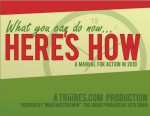Publishers, including The New York Times, Hachette, and Penguin) are panicking over e-books. They’re resisting the Kindle, trying to force DRM, and retain end-to-end control over pricing.
However, according (ironically) to an article published in The Times itself on Jan. 22, 2010, other publishers have decided to embrace e-books – and find ways to make money by actually giving books away.
It’s part of what Seth Godin calls the “gift” culture in his new book, Linchpin (plain old link). Gifts bring us closer, and free can actually earn more money.
How does this work?
HarperCollins and Scholastic, among others, are offering free downloads of books by new or little-known authors for a limited time. The idea is that if the readers like the free book, they’ll want to come back and buy more books by the same writer.
Earn money with free
For example, Samhain publishing offered free digital versions of a romance novel. It was downloading 26,897 times. Meanwhile, sales of the author’s two other books went from 97 and 119 to 2,666 and 3,297 respectively. Not huge numbers, true, but found money for both publisher and author.
You can do it too
This works in other businesses too. Give away the information and posts in your blog for free. Offer e-books, newsletters, free articles, and white papers as downloads. Let them spread. Give readers permission to re-post them and share them (with credit). Spread your ideas.
Then, add paid how-to workbooks, bundle posts with extra information and create paid e-books, add video or audio and you’ve got a workshop. The more specific, personal, and unique the service, the higher the value, and the more it costs.
Are you using free information to make money? Share your stories in the comments.
Image: mydogsighs





